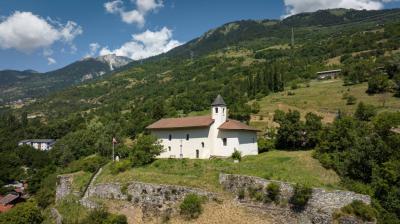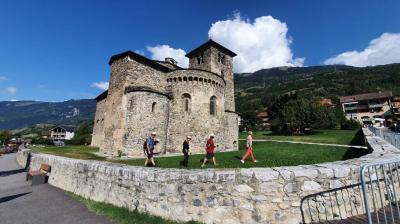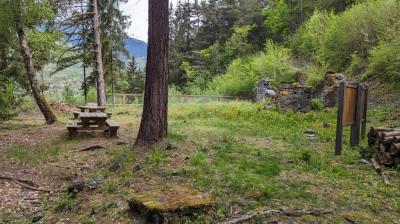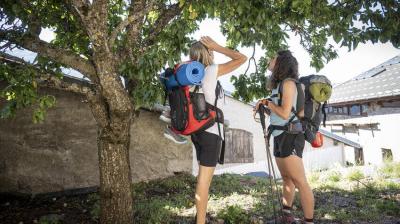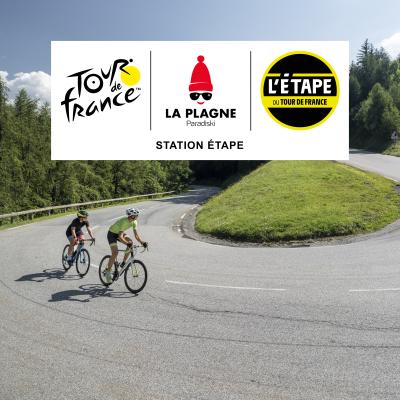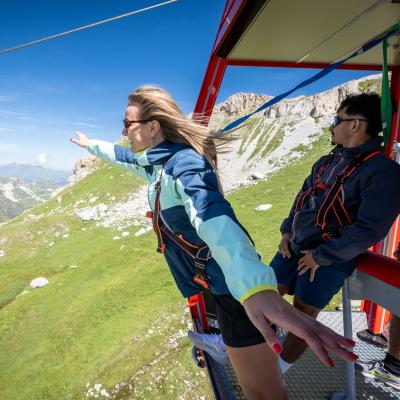Known as Axima during the Roman Empire, Aime has always been a transit town, for commerce first of all and then for tourism. The small town continues the Savoyard tradition of welcoming visitors and offers a number of curiosities to discover.
Saint Martin's Basilica
The Romans envied the Tarentaise valley with its ideal situation on the road connecting Milan to Vienne (France). they envied its micro climate and they already spoke about the pretty russet-coloured cows (the Tarine or Tarentaise breed of cows), whose milk made such good cheese: the "caesum vatusicum", the predecessor of Tomme cheese.
Excellent strategists, they subdued the Gallic Ceutrones in around 21 BC and made Aime, under the name of Axima, the capital of the province of the Graian Alps which covered part of the current Savoie and Haute Savoie departments.
From this era, apart from the objects that can be seen in the Pierre Borrione museum, we have the remains of a Roman building. Destroyed when the Ormente river flooded, the early Christians built a first Church on the ruins. After this was destroyed by a fire, the constructors of the year 1000 built, a jewel of Savoyard Roman art in the same place: Saint-Martin's basilica. Listed as a historical monument in 1875, it has not been used as a place of worship for several centuries.
Do not miss: the 13th century frescoes in the choir, the engraved stones from Roman times, the semi-underground crypt and the temporary exhibitions.
The Montmayeur Castle
The initial construction of this keep was a square tower protected by an enclosure.
In feudal times, the powerful titled families shared the land and the Montmayeur family, like the Count of Savoie, were vassals of the Holy Roman Empire.
Living in the lower part of the town, they controlled traffic on the Isère river.
As new weapons were developed, the medieval tower no longer fulfilled its defensive role. With a main building, a turret with a spiral staircase, and some interior fittings, this keep was a pleasant residence during the Renaissance. Abandoned over the centuries and finally purchased by the commune, it is now used for exhibitions.
Do not miss:
On 3 floors, models, drawings and sound effects reveal the secrets of the traditional buildings in the valley, from the town houses to the chalets in the Alpine pastures.
In the cellar, you can discover what wine was like in the Middle Ages (you can go back in time and try some Hippocras) and what tools were used to work the land.
in the main building, there is a reconstitution of a scene from medieval life.
Game: translating a medieval text.
Audiovisual screen showing a documentary called “The Shared Kingdom” produced by Pascal Bellemin-Bertaz and Didier Bouillot (in French and Italian).
4th floor
Historical maps
- The Kingdom of Burgundy and Savoie (year 1000)
- The structuring of the Savoie principality (11th -16th century)
- The place of the Montmayeur family in the Savoie principality
Educational wooden games
- Reconstitution of the Montmayeur castle in the 13th century
- Emergence of sports and games in the Middle Ages
Of Stones and Men: the Pierre Borrione archeological museum
At the top of the ancient Gallic oppidum, offering a remarkable view of the valley and the surrounding peaks, the archaeological museum has the particularity of displaying its objects in a former church.
The history starts in the Neolithic era and takes us through to modern times.
The name of the museum comes from a former mayor of Aime and a visionary who, to anticipate the closing of La Plagne's mines, worked with other communes to create the resort of La Plagne.
Today, Aime's Historical and Archeological Society manages the collections of this museum which has been labelled a "Musée de France".
Guided tours organised in collaboration with the La Plagne Vallée tourist office.
Do not miss
An exhibition on minerals worldwide
Antique archaeological remains
Models of bell towers in the Tarentaise
The silver-bearing lead mines
The Romans envied the Tarentaise valley with its ideal situation on the road connecting Milan to Vienne (France). they envied its micro climate and they already spoke about the pretty russet-coloured cows (the Tarine or Tarentaise breed of cows), whose milk made such good cheese: the "caesum vatusicum", the predecessor of Tomme cheese.
Excellent strategists, they subdued the Gallic Ceutrones in around 21 BC and made Aime, under the name of Axima, the capital of the province of the Graian Alps which covered part of the current Savoie and Haute Savoie departments.
From this era, apart from the objects that can be seen in the Pierre Borrione museum, we have the remains of a Roman building. Destroyed when the Ormente river flooded, the early Christians built a first Church on the ruins. After this was destroyed by a fire, the constructors of the year 1000 built, a jewel of Savoyard Roman art in the same place: Saint-Martin's basilica. Listed as a historical monument in 1875, it has not been used as a place of worship for several centuries.
Do not miss: the 13th century frescoes in the choir, the engraved stones from Roman times, the semi-underground crypt and the temporary exhibitions.
The Montmayeur Castle
The initial construction of this keep was a square tower protected by an enclosure.
In feudal times, the powerful titled families shared the land and the Montmayeur family, like the Count of Savoie, were vassals of the Holy Roman Empire.
Living in the lower part of the town, they controlled traffic on the Isère river.
As new weapons were developed, the medieval tower no longer fulfilled its defensive role. With a main building, a turret with a spiral staircase, and some interior fittings, this keep was a pleasant residence during the Renaissance. Abandoned over the centuries and finally purchased by the commune, it is now used for exhibitions.
Do not miss:
On 3 floors, models, drawings and sound effects reveal the secrets of the traditional buildings in the valley, from the town houses to the chalets in the Alpine pastures.
In the cellar, you can discover what wine was like in the Middle Ages (you can go back in time and try some Hippocras) and what tools were used to work the land.
in the main building, there is a reconstitution of a scene from medieval life.
Game: translating a medieval text.
Audiovisual screen showing a documentary called “The Shared Kingdom” produced by Pascal Bellemin-Bertaz and Didier Bouillot (in French and Italian).
4th floor
Historical maps
- The Kingdom of Burgundy and Savoie (year 1000)
- The structuring of the Savoie principality (11th -16th century)
- The place of the Montmayeur family in the Savoie principality
Educational wooden games
- Reconstitution of the Montmayeur castle in the 13th century
- Emergence of sports and games in the Middle Ages
Of Stones and Men: the Pierre Borrione archeological museum
At the top of the ancient Gallic oppidum, offering a remarkable view of the valley and the surrounding peaks, the archaeological museum has the particularity of displaying its objects in a former church.
The history starts in the Neolithic era and takes us through to modern times.
The name of the museum comes from a former mayor of Aime and a visionary who, to anticipate the closing of La Plagne's mines, worked with other communes to create the resort of La Plagne.
Today, Aime's Historical and Archeological Society manages the collections of this museum which has been labelled a "Musée de France".
Guided tours organised in collaboration with the La Plagne Vallée tourist office.
Do not miss
An exhibition on minerals worldwide
Antique archaeological remains
Models of bell towers in the Tarentaise
The silver-bearing lead mines
Prices
Free access. Visite libre des 3 édifices (période estivale) : 4€ par édifice
Visite guidée des édifices (hors période estivale) :
- 1 édifice : Adulte : 6 €, Enfant : 3 €
- 2 édifices : Adulte : 11 €, Enfant : 5 €
Scolaire 2,50€ / gratuit pour les enseignants.
Visite guidée des édifices (hors période estivale) :
- 1 édifice : Adulte : 6 €, Enfant : 3 €
- 2 édifices : Adulte : 11 €, Enfant : 5 €
Scolaire 2,50€ / gratuit pour les enseignants.
Opening
All year round, daily.
Historical Aime
1139 avenue de Tarentaise Aime
73210 Aime-la-Plagne
73210 Aime-la-Plagne
Altitude
700m
La Plagne Vallée



